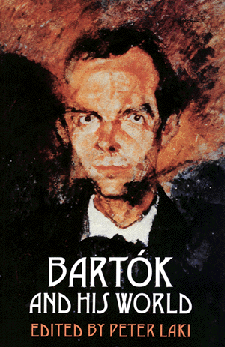Any genuine understanding of the role of Béla Bartók in twentieth century music is contingent on knowing about the cultural context in which he was formed — or in which he formed himself, as seems likely to be the case. The understanding is two-pronged, as Judit Frigyesi, in Béla Bartók and Turn-of-the-Century Budapest and Peter Laki, in Bartók and His World, make clear.
 Frigyesi focuses on the cultural, social and political context of Budapest before World War I, specifically the years before 1911; Laki’s anthology also gives pride of place to this period, but contains forays into Bartók’s later life and activities. The two are excellent complements for anyone wanting a solid take on Bartók and his genesis.
Frigyesi focuses on the cultural, social and political context of Budapest before World War I, specifically the years before 1911; Laki’s anthology also gives pride of place to this period, but contains forays into Bartók’s later life and activities. The two are excellent complements for anyone wanting a solid take on Bartók and his genesis.
Hungary in the years before the collapse of the Habsburg Empire was an anomaly: on the one hand, it was considered a cultural backwater dependent on the capitals of Western Europe for its cultural life; on the other hand, it was an old, proud country with rich traditions of its own, forced into obscurity by the march of European politics — as much a function of chance as anything else. Bartók’s career, and those of his contemporaries, involved not only a search for a voice that was genuinely and uniquely “Hungarian” but the establishment of that voice within the mainstream of modern cultural thought.
One cannot understate the role of literature in the Hungarian experience. As Frigyesi points out, unlike the U.S., no Hungarian can be considered intellectually aware without a knowledge and appreciation of Hungarian poetry; to a certain extent, this seems to hold true of Hungarian drama as well — two of Bartók’s collaborators, Béla Balász, who wrote Duke Bluebeard’s Castle, and Melchior Lengyel, the creator of the pantomime The Miraculous Mandarin, were key figures in Budapest’s cultural life, and the poet Endre Ady was tremendously influential on Bartók and others of the period. (Both Balász and Lengyel merit separate essays in Laki’s volume, as well as extensive discussion in Frigyesi’s work; Ady is a ongoing thread throughout, and in fact is essential to the last major section of Frigyesi’s study.)
The dual strands of romanticism and modernism also come into play. Frigyesi provides a fascinating discussion of the role of romanticism, particularly the idea of the work of art as something not only completely original but as a Ding an sich, a concept completely self-referential, maintaining a kind of purity in the realm of ideas. This is something that carried through to the thinking of Schoenberg and Stravinsky, who with Bartók comprise the Big Three of European modernism. David Schneider, in Laki’s volume, provides welcome amplification of the influence of Stravinsky, in particular, on Bartók’s development. I found his reference to Bartók’s two piano concertos as responses to Stravinsky’s Concerto for Piano and Winds illuminating, although he seems to miss a significant point: Bartók’s Second Concerto presents, after a period of synthesis, not only a significant response to Stravinsky’s modernism, but one that incorporates Bartók’s researches into Hungarian folk music as a substantive and integral part of the vocabulary: Bartók did nothing so superficial as incorporating folk melodies, but adopted the basic structures of folk music into high art, which is something that seems to have echoed in the realm of art music ever since.
 Bartók’s influence on his contemporaries was not substantial. However, after World War II (and unfortunately, after the composer’s death), his work found increasing popularity, and I would venture to say that his influence on music after 1948 has been profound: as composers moved away from traditional forms and evidenced a greater interest in music from vernacular sources and non-Western traditions, I think Bartók has been an increasingly important motivating factor. It is hard for us to understand, perhaps, just how radical his music was and how difficult audiences found it (The Miraculous Mandarin was another of those works that was greeted by a riot at its premiere) when today it sounds so normal.
Bartók’s influence on his contemporaries was not substantial. However, after World War II (and unfortunately, after the composer’s death), his work found increasing popularity, and I would venture to say that his influence on music after 1948 has been profound: as composers moved away from traditional forms and evidenced a greater interest in music from vernacular sources and non-Western traditions, I think Bartók has been an increasingly important motivating factor. It is hard for us to understand, perhaps, just how radical his music was and how difficult audiences found it (The Miraculous Mandarin was another of those works that was greeted by a riot at its premiere) when today it sounds so normal.
As I noted, these two books make exemplary companions. Frigyesi’s has the strength of being a thoroughly detailed and highly focused study, while Laki’s collection adds to that detail and highlights significant points in the composer’s career. It also contains two interviews with Bartók, a selection of his letters, and a section of poetry that was inspired by or commented on the composer and his work. The letters, in particular, provide an absorbing portrait of the man who was, when all is said and done, one of the most important musicians of the twentieth century.
(University of California Press, 1998)
(Princeton University Press, 1995)
